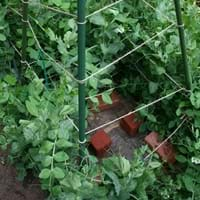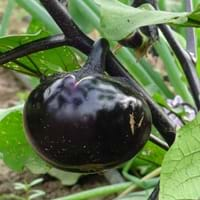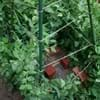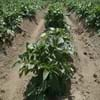Life Span
Annual
Perennial
Origin
Europe, Mediterranean, Asia
Africa, Asia
Types
determinate, indeterminate
esculentum, depressum, serpentium
Habitat
Fields, Floodplain, gardens
Anthropogenic, Wild
USDA Hardiness Zone
Not Available
10-12
Sunset Zone
A1, A2, A3, H1, H2, 1a, 1b, 2a, 2b, 3a, 3b, 4, 5, 6, 7, 8, 9, 10, 11, 12, 13, 14, 15, 16, 17, 18, 19, 20, 21, 22, 23, 24
A1, A2, A3, H1, H2, 1a, 1b, 2a, 2b, 3a, 3b, 4, 5, 6, 7, 8, 9, 10, 11, 12, 13, 14, 15, 16, 17, 18, 19, 20, 21, 22, 23, 24
Habit
Vining/Climbing
Clump-Forming
Minimum Width
Not Available
Flower Color
White, Pink, Lavender
Lavender
Flower Color Modifier
Bicolor
Bicolor
Fruit Color
Green
White, Purple, Plum, Black
Leaf Color in Spring
Green, Gray Green
Green
Leaf Color in Summer
Not Available
Green
Leaf Color in Fall
Green, Gray Green
Green
Leaf Color in Winter
Green, Gray Green
Green
Leaf Shape
Cordate
Broad, Unlobed
Plant Season
Spring, Fall, Winter
Summer, Fall
Sunlight
Full Sun, Partial Sun
Full Sun
Growth Rate
Fast
Very Fast
Type of Soil
Clay, Loam, Sand
Clay, Loam, Sand
The pH of Soil
Neutral
Neutral
Soil Drainage
Well drained
Well drained
Bloom Time
Early Spring, Spring, Late Spring, Winter, Late Winter
Indeterminate
Tolerances
Drought
Drought
Where to Plant?
Container, Ground
Container, Ground
How to Plant?
Seedlings
Seedlings, Transplanting
Plant Maintenance
Medium
Medium
Watering Requirements
Keep ground moist, Reduce water once established, Water frequently while growing
Average Water Needs, Keep the ground moist but not water-logged
In Summer
Lots of watering
Average Water
In Spring
Moderate
Moderate
In Winter
Average Water
Average Water
Soil Type
Clay, Loam, Sand
Clay, Loam, Sand
Soil Drainage Capacity
Well drained
Well drained
Sun Exposure
Full Sun, Partial Sun
Full Sun
Pruning
Remove damaged leaves, Remove dead branches, Remove dead leaves
Remove damaged leaves, Remove dead branches, Remove dead leaves
Fertilizers
All-Purpose Liquid Fertilizer
All-Purpose Liquid Fertilizer, Apply 10-10-10 amount
Pests and Diseases
Red blotch
Aphids, Beetles, Blight, Cutworms, Flea Beetles, Leaf spot, Red blotch
Plant Tolerance
Drought
Drought
Flower Petal Number
Single
Single
Fragrant Bark/Stem
No
Yes
Foliage Texture
Medium
Medium
Foliage Sheen
Matte
Matte
Attracts
Not Available
Aphids, Beetles, Insects, Not Available
Allergy
Mouth itching, Swelling in mouth
contact allergic dermatitis, Headache, Itchiness
Aesthetic Uses
Not Available
Not Used For Aesthetic Purpose
Beauty Benefits
Not Available
Skin cleanser
Environmental Uses
Air purification
Air purification
Medicinal Uses
Not Available
Potassium, Rich in Iron, Vitamin C, Vitamin E, Vitamin K
Part of Plant Used
Beans, Leaves
Fruits, Leaves
Other Uses
Edible seed
Food for animals, Used as a nutritious food item, Used for its medicinal properties
Used As Indoor Plant
No
Yes
Used As Outdoor Plant
Yes
Yes
Garden Design
Edible, Herb, Vegetable, Vine
Container, Edible, Herb / Vegetable
Botanical Name
PISUM sativum var macrocarpon
SOLANUM melongena 'Ichiban'
Common Name
magnetout
Eggplant, Ichiban Eggplant, Japanese Eggplant
In French
Snow Pea
Aubergine
In Spanish
tirabeque, bisalto
Berenjena
In Greek
Μπιζέλια
Μελιτζάνα
In Portuguese
ervilhas
Berinjela
In Polish
groszek cukrowy
Bakłażan
Phylum
Not Available
Magnoliophyta
Class
Not Available
Magnoliopsida
Family
Fabaceae
Solanaceae
Clade
Angiosperms, Eudicots, Rosids
Angiosperms, Asterids
Tribe
Not Available
Solaneae
Subfamily
Faboideae
Solanoideae
Number of Species
Not Available
Not Available
Season and Care of Snow Pea and Eggplant
Season and care of Snow Pea and Eggplant is important to know. While considering everything about Snow Pea and Eggplant Care, growing season is an essential factor. Snow Pea season is Spring, Fall and Winter and Eggplant season is Spring, Fall and Winter. The type of soil for Snow Pea is Clay, Loam, Sand and for Eggplant is Clay, Loam, Sand while the PH of soil for Snow Pea is Neutral and for Eggplant is Neutral.
Snow Pea and Eggplant Physical Information
Snow Pea and Eggplant physical information is very important for comparison. Snow Pea height is 30.00 cm and width Not Available whereas Eggplant height is 60.00 cm and width 30.00 cm. The color specification of Snow Pea and Eggplant are as follows:
Snow Pea flower color: White, Pink and Lavender
Snow Pea leaf color: Green and Gray Green
Eggplant flower color: Lavender
- Eggplant leaf color: Green
Care of Snow Pea and Eggplant
Care of Snow Pea and Eggplant include pruning, fertilizers, watering etc. Snow Pea pruning is done Remove damaged leaves, Remove dead branches and Remove dead leaves and Eggplant pruning is done Remove damaged leaves, Remove dead branches and Remove dead leaves. In summer Snow Pea needs Lots of watering and in winter, it needs Average Water. Whereas, in summer Eggplant needs Average Water and in winter, it needs Average Water.





